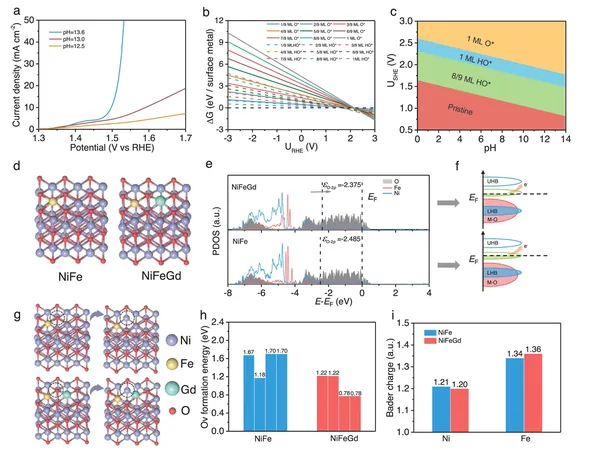
Revolutionary Discovery: New Catalyst Significantly Boosts Hydrogen Production Efficiency!
2025-03-12
Author: Daniel
Introduction
In the quest for clean hydrogen energy, the oxygen evolution reaction (OER) has posed significant challenges due to its sluggish and inefficient nature. Fortunately, cutting-edge research reveals a promising breakthrough that could change the game in renewable energy production.
Breakthrough in Catalysis
Scientists at Tohoku University have discovered that introducing gadolinium (Gd) into iron (Fe)-doped nickel oxide (NiO) dramatically enhances the activity of OER, making the process of generating hydrogen from water much more efficient. This new catalyst is not just innovative; it is also abundant, cost-effective, nontoxic, and stable—ideal qualities for practical applications.
Enhancement Mechanisms
The study, published in the prestigious journal Advanced Functional Materials, unveils how density functional theory (DFT) calculations were employed to deeply analyze the underlying reaction mechanisms. The results showed that Gd-doping enhances OER performance by creating oxygen vacancies. These vacancies enable a more efficient lattice oxygen oxidation mechanism, crucial for speeding up reactions.
Performance Improvements
Remarkably, the Gd-doped catalyst exhibited a reduction of 40 mV in the hypothetical overpotentials compared to its Fe-doped counterpart, which could lead to significant improvements in energy efficiency. Additionally, the catalyst demonstrated favorable kinetics with a Tafel slope of just 43.1 mV dec-1, underlining its superior performance.
Long-term Stability
But that’s not all. This innovative Gd and Fe co-doped NiO catalyst showcases impressive long-term stability, exceeding 150 hours in sustained tests. It proved its robustness in practical applications by operating effectively within an anion exchange membrane water electrolysis system for over 120 continuous hours.
Research Significance
Hao Li, an associate professor at Tohoku University's Advanced Institute for Materials Research (WPI-AIMR), emphasized the importance of this research: 'This advancement plays a crucial role in accelerating the development of green energy technologies, particularly in refining water electrolysis. This is key in producing green hydrogen from renewable sources such as wind and solar energy.'
Broader Impact of Green Hydrogen
Green hydrogen is pivotal for combatting climate change, with extensive applications including fuel cell vehicles, industrial processes, and other high-energy sectors. By enhancing electrolysis efficiency, this discovery lays the groundwork for large-scale hydrogen production, moving us closer to reducing our reliance on fossil fuels and cutting down greenhouse gas emissions.
Future Directions
Looking to the future, Li and his team are determined to scale up the production process to ensure consistent output for industrial applications, as well as conduct extended stability tests under various realistic conditions.
Conclusion
This breakthrough not only paves the way for more sustainable energy solutions but also promises to revolutionize the landscape of hydrogen energy production. Stay tuned—this could just be the beginning of a sustainable energy renaissance!




 Brasil (PT)
Brasil (PT)
 Canada (EN)
Canada (EN)
 Chile (ES)
Chile (ES)
 Česko (CS)
Česko (CS)
 대한민국 (KO)
대한민국 (KO)
 España (ES)
España (ES)
 France (FR)
France (FR)
 Hong Kong (EN)
Hong Kong (EN)
 Italia (IT)
Italia (IT)
 日本 (JA)
日本 (JA)
 Magyarország (HU)
Magyarország (HU)
 Norge (NO)
Norge (NO)
 Polska (PL)
Polska (PL)
 Schweiz (DE)
Schweiz (DE)
 Singapore (EN)
Singapore (EN)
 Sverige (SV)
Sverige (SV)
 Suomi (FI)
Suomi (FI)
 Türkiye (TR)
Türkiye (TR)
 الإمارات العربية المتحدة (AR)
الإمارات العربية المتحدة (AR)